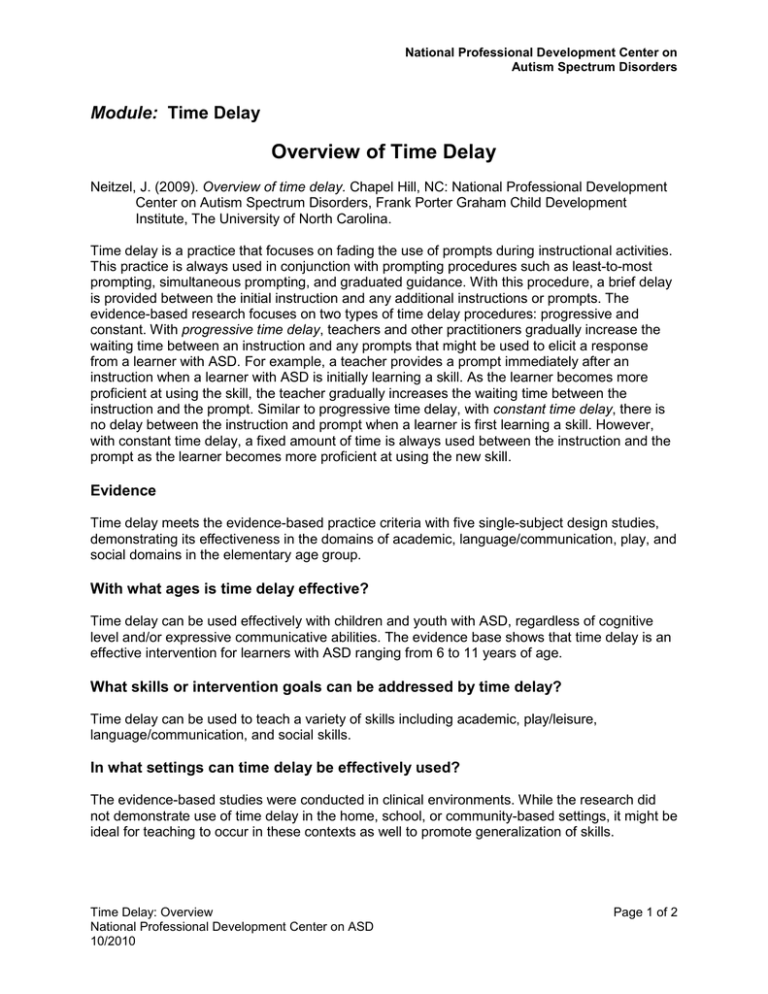Overview of Time Delay
advertisement

National Professional Development Center on Autism Spectrum Disorders Module: Time Delay Overview of Time Delay Neitzel, J. (2009). Overview of time delay. Chapel Hill, NC: National Professional Development Center on Autism Spectrum Disorders, Frank Porter Graham Child Development Institute, The University of North Carolina. Time delay is a practice that focuses on fading the use of prompts during instructional activities. This practice is always used in conjunction with prompting procedures such as least-to-most prompting, simultaneous prompting, and graduated guidance. With this procedure, a brief delay is provided between the initial instruction and any additional instructions or prompts. The evidence-based research focuses on two types of time delay procedures: progressive and constant. With progressive time delay, teachers and other practitioners gradually increase the waiting time between an instruction and any prompts that might be used to elicit a response from a learner with ASD. For example, a teacher provides a prompt immediately after an instruction when a learner with ASD is initially learning a skill. As the learner becomes more proficient at using the skill, the teacher gradually increases the waiting time between the instruction and the prompt. Similar to progressive time delay, with constant time delay, there is no delay between the instruction and prompt when a learner is first learning a skill. However, with constant time delay, a fixed amount of time is always used between the instruction and the prompt as the learner becomes more proficient at using the new skill. Evidence Time delay meets the evidence-based practice criteria with five single-subject design studies, demonstrating its effectiveness in the domains of academic, language/communication, play, and social domains in the elementary age group. With what ages is time delay effective? Time delay can be used effectively with children and youth with ASD, regardless of cognitive level and/or expressive communicative abilities. The evidence base shows that time delay is an effective intervention for learners with ASD ranging from 6 to 11 years of age. What skills or intervention goals can be addressed by time delay? Time delay can be used to teach a variety of skills including academic, play/leisure, language/communication, and social skills. In what settings can time delay be effectively used? The evidence-based studies were conducted in clinical environments. While the research did not demonstrate use of time delay in the home, school, or community-based settings, it might be ideal for teaching to occur in these contexts as well to promote generalization of skills. Time Delay: Overview National Professional Development Center on ASD 10/2010 Page 1 of 2 National Professional Development Center on Autism Spectrum Disorders Module: Time Delay Evidence Base The studies cited in this section document that this practice meets the NPDC on ASD’s criteria for an evidence-based practice. This list is not exhaustive; other quality studies may exist that were not included. Elementary Charlop, M. H., Schreibman, L., & Thibodeau, M. G. (1985). Increasing spontaneous verbal responding in autistic children using a time delay procedure. Journal of Applied Behavior Analysis, 18, 155-166. Ledford, J. R., Gast, D. L., Luscre, D., & Ayres, K. M. (2008). Observational and incidental learning by children with autism during small group instruction. Journal of Autism and Developmental Disorders, 38, 86-103. Liber, D. B., Frea, W. D., & Symon, J. B. G. (2008). Using time delay to improve social play skills with peers for children with autism. Journal of Autism and Developmental Disorders, 38, 312-323. Matson, J. L., Sevin, J. A., Fridley, D., & Love, S. R. (1990). Increasing spontaneous language in three autistic children. Journal of Applied Behavior Analysis, 23, 227-233. Taylor, B. A., & Harris, S. L. (1995). Teaching children with autism to seek information: Acquisition of novel information and generalization of responding. Journal of Applied Behavior Analysis, 28, 3-14. Selected Additional Resources Wolery, M., & Wilburs, J.S. (1994). Introduction to the inclusion of young children with special needs in early childhood programs. In M. Wolery & J.S. Wilbers (Eds.), Including children with special needs in early childhood programs (pp. 1-22). Washington, DC: National Association for the Education of Young Children. Time Delay: Overview National Professional Development Center on ASD 10/2010 Page 2 of 2


